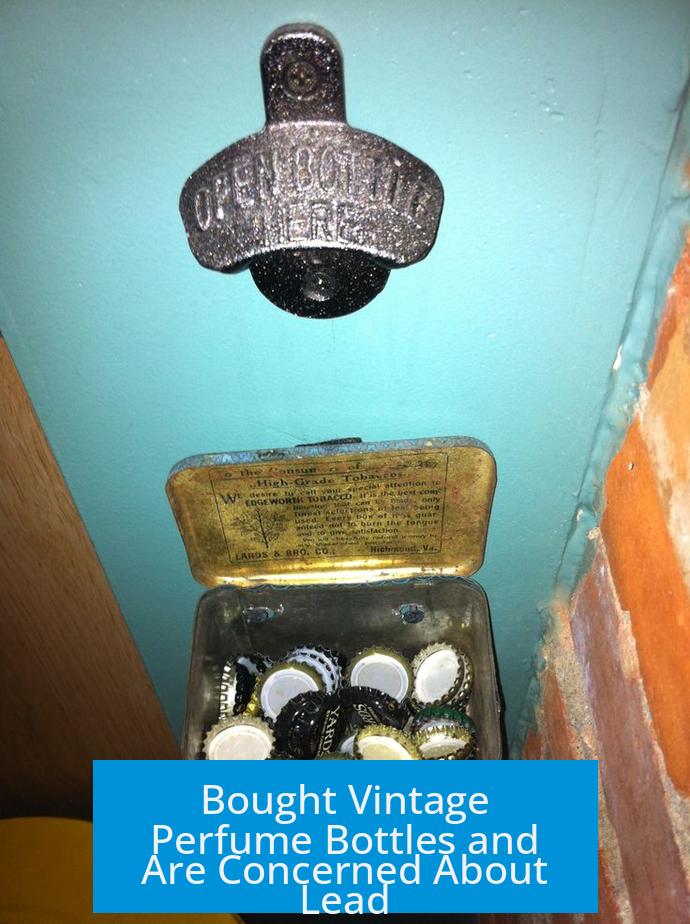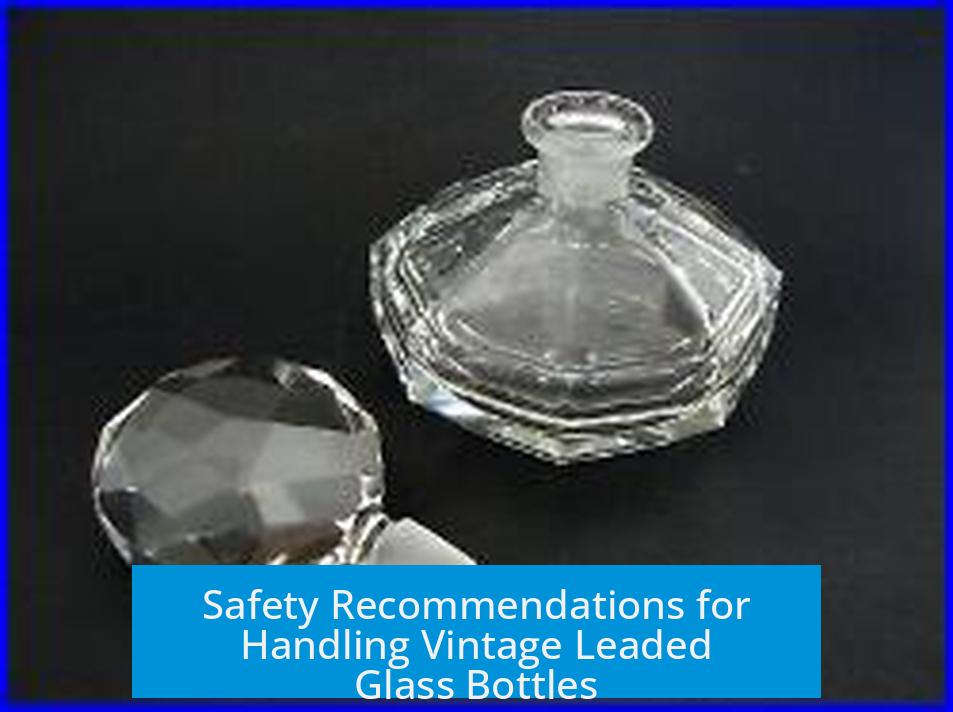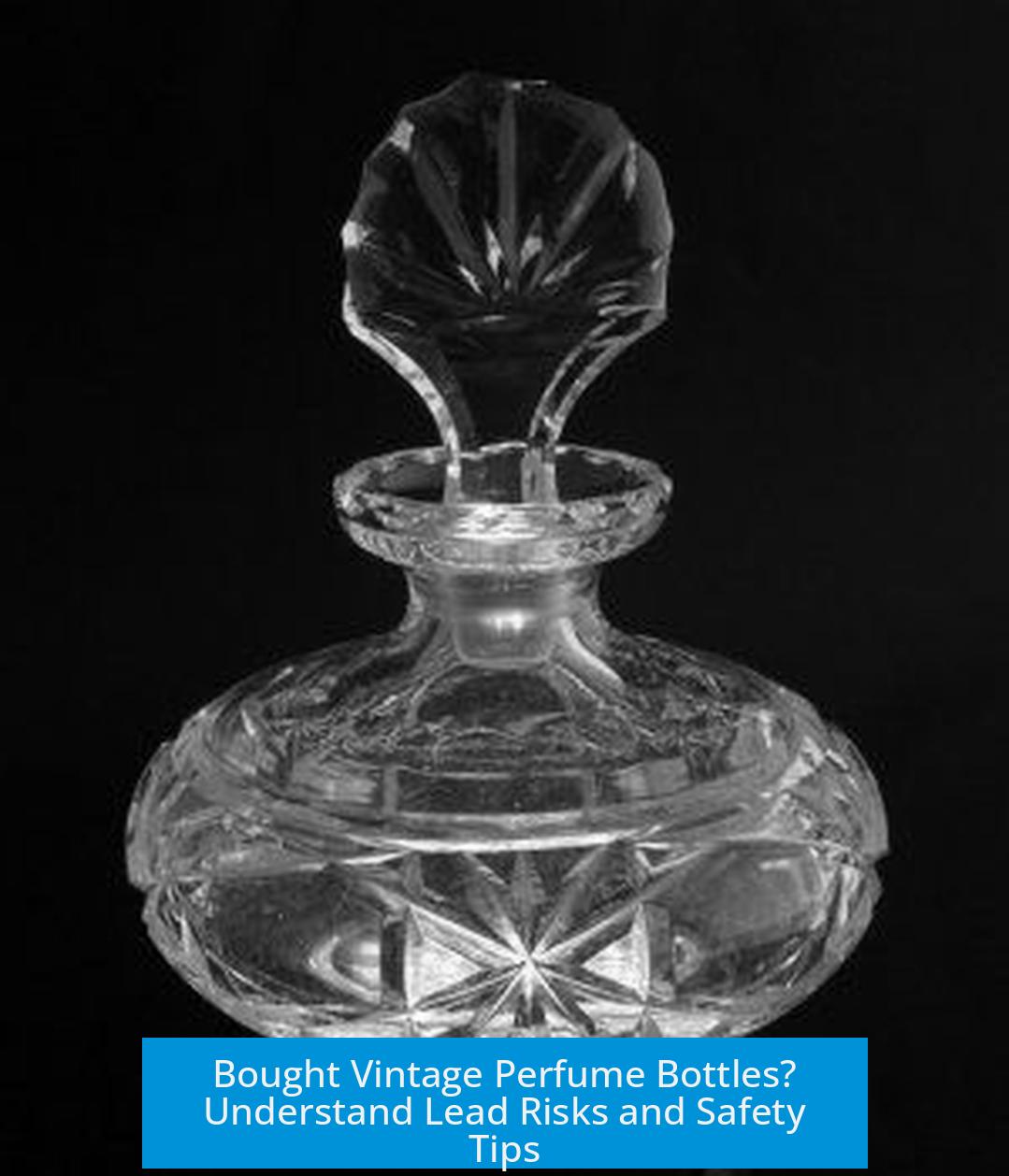Bought Vintage Perfume Bottles and Are Concerned About Lead?

Vintage perfume bottles, especially those made of crystal, might contain lead. However, the risk of lead exposure from handling or using these bottles is minimal if basic precautions are taken. Leaded glass is primarily a concern when storing acidic liquids for long periods or ingesting lead-contaminated substances. For collectors and users, knowing the facts and following safety measures ensures enjoyment without health worries.
Understanding Lead in Vintage Crystal/Glass Perfume Bottles
Many vintage glass and crystal perfume bottles contain lead oxide. Lead oxide is used during manufacturing to increase the glass density and provide the sparkling clarity characteristic of crystal.
- All crystal glass produced before 2009 is leaded, and some crystal is still leaded as late as 2023.
- Lead makes the glass heavier and gives it a distinctive clear sound when tapped.
- Ordinary glass used in bottles usually lacks lead and is lighter with no special ringing sound.
Thus, vintage perfume bottles made from crystal often contain lead. This means that the glass itself includes significant lead percentages embedded within its structure, making it denser and brighter than standard glass bottles.
Risks of Lead Exposure From Handling or Using Bottles
Touching vintage leaded glass perfume bottles generally does not pose a health risk. Lead in crystal is tightly bound within the glass matrix and does not readily transfer to skin from handling.
- Simply touching or holding the bottles poses almost no danger of lead poisoning.
- Lead absorption through intact skin from trace lead dissolved in perfume is negligible.
- Adults are less susceptible to adverse effects from small, incidental lead exposure compared to children.
- Washing hands after handling these bottles is a practical precaution but not essential unless the glass is damaged.
- Lead poisoning mainly arises through ingestion or inhalation, not skin contact.
Only extreme scenarios, such as deliberately ingesting or chewing crystal, would increase lead exposure. In typical use and display, the lead in vintage bottles is safely locked in place.
Concerns About Storing Liquids in Leaded Glass Bottles
Lead glass is most problematic when it stores acidic substances over long durations. Lead can leach out into the liquid, which may subsequently be consumed.
- Storing acidic beverages (wine, vinegar, or citrus juices) in leaded glass decanters or bottles for weeks or months can leach lead into the liquid.
- Perfume often has an acidic pH, but it is applied externally and used in tiny amounts, posing little risk.
- Lead leached from perfume glass is unlikely to enter the body significantly because perfume contacts skin, not internal tissues.
- Modern leaded glassware designed for beverages often uses inner non-lead liners to prevent lead leaching.
Using vintage perfume bottles strictly for their original perfume purpose is generally safe. Avoid using leaded glass for storage of acidic food or drink items intended for consumption.
Safety Recommendations for Handling Vintage Leaded Glass Bottles

To minimize any potential risks, collectors or users can take prudent precautions:
- Assume vintage crystal bottles contain lead unless tested otherwise.
- Avoid licking or chewing the glass.
- Wash hands after handling, especially if the bottle has chips or cracks that might expose lead particles.
- Consider sealing the interior surface with a clear, resistant coating like gel nail polish to create a barrier.
- Soak the bottle in vinegar for a few days followed by a thorough wash to bind and remove surface lead.
- If storing perfume inside the bottle, avoid prolonged storage to reduce lead exposure risks.
These measures help prevent lead contact while maintaining the bottle’s aesthetic value.
How to Identify Whether Your Bottle Contains Leaded Glass
Identifying lead content in vintage perfume bottles can be done through several observable traits and testing:
- Weight and Density: Leaded glass is heavier and denser than normal glass of the same size.
- Appearance: Lead crystal is shinier, clearer, and often features intricate cut designs without mold seams.
- Sound: When gently tapped, crystal emits a distinct ringing tone compared to dull sounds from regular glass.
- Lead Test Kits: Swab tests can detect lead presence; occupational safety kits are suitable for testing bottle interiors.
- Measuring Density: Using a precision scale and volume measurement can help estimate lead content indirectly.
These methods help collectors confirm if their perfume bottles contain lead and take necessary precautions accordingly.
Lead Risks Focus Primarily on Children and Chronic Exposure
The toxicological concern with lead centers on vulnerable populations, particularly children, due to its adverse effects on brain development.
- Adults usually experience minimal harm from trace lead exposure through typical handling of vintage bottles.
- Lead poisoning risks are higher from sources like lead-contaminated water pipes or old paint dust rather than glassware.
- Lead bound in solid crystal structure poses less bioavailability than free lead particles or dissolved lead.
Thus, adults handling vintage perfume bottles seldom face significant health threats related to lead.
Additional Context and Resources
Experts and enthusiasts widely agree that leaded glass can be safely handled with normal precautions. Studies on lead leaching from crystal drinkware indicate minimal consumption risk when not used for prolonged storage of acidic liquid.
For further reading, authoritative video resources analyze lead content in lead crystal glass and demonstrate safe use:
Regulations mainly protect glass factory workers from lead exposure during manufacturing rather than end consumers of crystal products.
Practical Tips for Enjoying Vintage Perfume Bottles Safely
- Display vintage bottles as art pieces rather than use them for drinking or food storage.
- Do not use the bottles as drinking glasses or shot glasses.
- Handle with care to avoid chipping and creating lead dust.
- If refilling, avoid prolonged storage of perfume or other liquids inside leaded glass bottles.
- Maintain hand hygiene after handling old or damaged bottles.
Following these straightforward guidelines ensures that collectors enjoy the beauty of vintage perfume bottles without health concerns.
Key Takeaways
- Many vintage crystal perfume bottles contain lead oxide, which makes the glass denser and shinier.
- Handling vintage leaded glass bottles poses minimal lead exposure risk under normal conditions.
- Lead can leach into acidic liquids stored long-term, but perfume use presents very low risk.
- Basic precautions include avoiding chewing glass, washing hands, and possibly coating the interior.
- Testing for lead presence can be done by weight, appearance, sound, or swab test kits.
- Lead poisoning risks are higher for children; adults face minimal risk when using vintage bottles responsibly.
- Enjoy vintage bottles as collectible items, not as food or drink containers.
Can vintage perfume bottles made of crystal contain lead?
Yes, many vintage crystal perfume bottles contain lead as part of their composition. Lead oxide is used to give crystal its density and shine. Bottles made before 2009 are often leaded glass.
Is it dangerous to handle or use vintage leaded glass perfume bottles?
Handling these bottles poses minimal risk. You won’t absorb significant lead by touching them. Washing hands after handling is enough to stay safe. Lead exposure mainly concerns children and prolonged contact.
Does storing perfume in leaded glass bottles increase lead exposure?
Lead can leach into acidic liquids over time, but perfume typically poses a low risk. The amount absorbed through skin contact is very small. Avoid drinking or storing acidic beverages long-term in leaded glass.
How can I reduce potential lead exposure from vintage perfume bottles?
Applying a clear gel nail polish inside the bottle can create a barrier. You can also soak bottles in vinegar to bond available lead before washing. Avoid licking or ingesting anything from these bottles.
How can I tell if my vintage perfume bottle contains lead?
Leaded glass is heavier, shinier, and rings when tapped. Look for cut designs and absence of mold lines. Lead test swab kits or density measurements can confirm presence of lead.





Leave a Comment